 The Philippine government will finally start seeking bidders for the P17-billion Davao Sasa port modernization project that will be carried out under a public-private partnersartment of Transportation and Communications (DOTC) and the Philippine Ports Authority (PPA) are inviting local and international participants to pre-qualify and bid for the right to finance, design, redevelop, operate, and maintain the Davao gateway, which was built during the mid-1990s by the Ramos administration.
The Philippine government will finally start seeking bidders for the P17-billion Davao Sasa port modernization project that will be carried out under a public-private partnersartment of Transportation and Communications (DOTC) and the Philippine Ports Authority (PPA) are inviting local and international participants to pre-qualify and bid for the right to finance, design, redevelop, operate, and maintain the Davao gateway, which was built during the mid-1990s by the Ramos administration.
The project calls for modernizing the existing port and establishing dedicated container-handling facilities, with an initial design capacity of 1,900 container ground slots to a minimum 2,700 ground slots. It also includes constructing a new apron, developing a linear quay, expanding a backup area, providing container yards and warehouses, and installing container-handling equipment over a 30-year concession period.
Currently, the Davao Sasa port has a total area of 18.1 hectares, a 1,093-meter quay, a berth depth of 11 meters, 4.15 hectares of container yard, 864 container ground slots, and a 0.2-hectare reefer yard.
DOTC has appointed the Development Bank of the Philippines and the International Finance Corp. of World Bank to act as transaction advisors.
Instructions to prospective bidders and the preliminary information memorandum will be available at the DOTC on April 14 for P300,000.
Plans to modernize and rehabilitate Davao Sasa have been on the drawing board for three years, with bidding moved several times. The contract of the port’s current cargo-handling operators—Davao Integrated Port and Stevedoring Services Corp. and Filipinas Port Services, Inc.—will expire in 2016.
Earlier, Edwin Banquerigo, provincial director of the Department of Trade and Industry-Davao, said Davao Sasa can no longer efficiently handle larger vessels due to its shallow depth, lack of modern cargo- handling facilities, congestion on land, and lack of space for cargo trucks.
Banquerigo added that most of the vessels calling the port are feeder vessels with an average capacity of only 300 TEUs to 500 TEUs.
The port has an annual capacity of 550,000 twenty-foot equivalent units (TEUs), and the largest vessel it has accommodated was an 800-TEU ship.
Located 10 kilometers north of downtown Davao City, Davao Sasa is the principal domestic and international seaport for most passengers and commodities in the Davao Region. It links the region to Hong Kong, China, Singapore, Australia, Europe, the Middle East, and the United States. – Roumina Pablo





